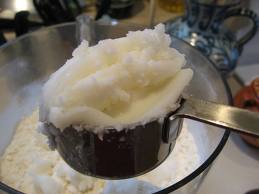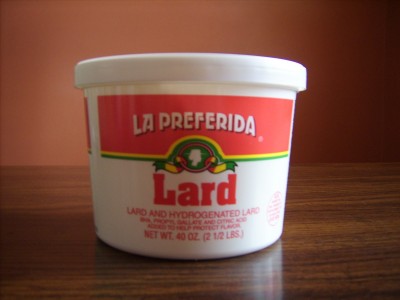Looking for Lard: Can you find it in a Grocery Store?
So often my “Make Your Own” recipes send me in search of ingredients that are unfamiliar to me. This week I wanted to purchase a pound of lard for a Homemade Birdseed Cake Recipe.
(Update: Click here for two more updated DIY Birdseed Cake recipes with lard)
I don’t know much at all about lard because I always use butter or margarine when I bake. I was hopeful that a simple trip down the baking aisle of the grocery store would do the trick. Such was not the case. There was no lard to be found anywhere on the baking aisle of the Meijer store where I shop.
Next I looked in the dairy case by the butter, I looked in the other end of the dairy case by the sour cream, I even looked in the cold meat section, and then the international food section, but once again, there was no lard to be found. So on this particular shopping trip I decided to buy Crisco instead.
Is Crisco the Same Thing as Lard?
The more I thought about substituting Crisco in my recipe, the more unhappy I became. After all, it wasn’t really the same stuff! So I consulted the great all-knowing Google to educate myself a little more about lard and other fats that are used in cooking. The best information I found was on a discussion forum for cooks. Here’s the link if you would like to read more: Discussion on interchanging fats in cooking (see answer #3) I’ll paraphrase as follows:
Butter: Butter is a dairy product and has the lowest melting point. It’s made of 80% fats and the rest is water. Butter is best used for its flavor. Because of its low melting point it burns more easily when using it to saute foods in a fry pan.
Margarine: Margarine is a vegetable product and was designed to be a cheap alternative to butter. It has about the same fat content, but it’s melting point is much higher. This is why you don’t get the same “melt in your mouth” quality as you get with baked goods made with butter, and it’s best use is for spreading on things. It’s a good alternative for vegetarians or for people who want to save money.
Lard: Lard is pork fat (tallow is beef fat). It has a much higher melting point and is good for making flakey baked goods and for deep frying. Lard does have a slight flavor, but it’s not a sweet flavor like butter.
Crisco: Crisco is a hydrogenated vegetable oil. Crisco is a little more dense than margarine and has no flavor. The introduction of Crisco is what made the use of lard in household cooking disappear. It was sold as a convenient alternative that would not go rancid. It also greatly increased the shelf life of ready-made foods.
So each of these fats have slightly different origins and properties. Many times they can be interchanged in baking but the texture and the flavor of the end product will be different, and it often comes down to the preference of the cook.
So Do Grocery Stores Still Sell Lard?
Once I realized that lard was from pork fat (I really did not know that!) I decided to try a little harder to find some, assuming the birds needed an animal fat with their seed, not some Crisco. I again consulted the all-knowing Google and discovered that Hispanic grocery stores carry lard and it is usually sold under the name “Manteca”. I have a grocery store near me with a large Hispanic section so off I went to check it out. Sure enough! There was Manteca on the shelf, and when I turned it around they had kindly labeled it in English too as “Lard”. It was sold in a 2.5 lb tub for $5.19.
I have seen other blog postings on the internet where lard has been used and the blogger has helpfully taken a picture of the ingredients. Other folks have apparently found lard in a one pound square block.
Is Lard Actually Healthy?
For many years now Lard has had a reputation as a bad fat that increases your cholesterol. Recently, however, scientists and the health community are taking another look. Lard is a more natural product than Crisco, which is an oil that has had its molecules changed. For generations lard and butter were the only fats used in cooking. In fact, William Proctor (who was a candle maker) and James Gamble (who was a soap maker) went into business in the early 1900’s to sell cottonseed oil as an alternative to butter and lard. They teamed up with a German chemist who discovered how to hydrogenate the oil into a solid. They realized it looked like lard and began to market their “Crisco” as an alternative.
And while lard is getting another look as a “good” fat, the general feeling is that it’s best to render your own lard if you want a product with a lower level of saturated fats.
Let’s Make Our Own Lard!
So now we have come full circle in the Make Your Own Zone! We should all be making our own lard! Oh I wish I was up to that challenge but I think I’ll save that for another day. Shame on me. For the curious and ambitious, however, here are a few links to show the way:
Making Fat – How To Render Lard
I guess if I was stymied by a recipe that started off with Lard as an ingredient, I would have the same problem with these recipes that start off with with things like “get yourself 2 lbs of pork fat”. Oh my! I would guess you need to be on good terms with your local butcher to accomplish that. It also appears that rendering your own lard is a smelly process. If any readers have tried this, or plan on trying it, I would love to hear about it!






I have what I guess you are calling tallow from making bone broth. Can I use that instead of lard? This article is very helpful, as I did not know what lard was.
Yes, I think what you have from making bone broth could substitute for tallow or lard, as they are all solidified fats.
How do you think bacon fat would do in a bird seed cake? I have tried it and it doesn’t harden like lard.. I’ve worried that it wasn’t good for the birds.
I’ve had other readers tell me they use bacon grease, and I’ve seen other bird cake recipes that use it too so I believe it is OK for the birds. If it is not totally hardening up for you, maybe use a mix of half lard and half bacon grease.
I have not been able to find Cuday’s Rex Lard for cooking. I would like to know where I can buy it. Either online or store in Tucson Az, Could you please help ?
Thank you
My research shows that this brand has not been manufactured for some time now and is no longer available. However the antique pails they used to be sold in appear to be a favorite on the antique market!
My family and friends say I’m the best pie maker in the world. My crusts, with lard in them, are the flakiest ever! I’m an 80 year old veteran pie maker and lard user. Nothing better than lard!!!!
Care to share your recipe? Unless it”s a family secret of course.
The brain lives on cholesterol. Up until about 100years ago, people ate food cooks with lard every day of their lives. In fact, the american diet was primary fatty meats potatoes along with mostly preserved fruits and fesg vegetables when in season. Wack jobs like Kelloggs and other came along and ruined it all. Our diet shifted to high in grains and carbs. Now we have an obesity epidemic with type 2 diabetes and alzheimers.
Thank you for the information! It was so helpful! I appreciate it!!
I miss LARD. I find shortning foams too much when used in frying.
Growing up in Ohio, we butchered hogs every winter, and rendering lard was one of the things that we did. Cutting the fat and rind into small chunks about an inch or two square was one of my earliest jobs.
Towards the end of the day, we would put a moderate fire back under our largest cast iron kettle and start loading the chunks of fat into it. A long wooden paddle was used to constantly stir the fat so as to keep it from burning to the bottom as it was rendered down to a liquid state.
Once the fat had become mostly liquid (still had a lot of chunks in it though), we would ladle it out into the lard press hopper where it would be strained and pour out of the bottom spout through a cheesecloth filter (grandma had previously sewn them together) into a 5 gallon lard can. When full, these cans would be set aside to cool and solidify.
Once the hopper of the lard press was full of un-melted chunks of fat/skin, the pressing mechanism would be installed and screwed down squeezing out the excess fatty liquid. The resulting cake was the “cracklings”.
On a side note, the tenderloins were strung up on a length of bailing twine (we called them “fish”) and deep fried in the cast iron kettle while rendering down the lard. With loaves of bread and grandma’s homemade pickles, these sandwiches were always a welcome treat after a long cold day of butchering.
Many grocery stores (bought mine at Food Lion in the Hispanic Section) sell a small aluminum pot with a lid and a strainer for pouring your bacon grease into. Storing this in your refrigerator keeps a supply of lard for most people’s needs these days.
r/
Matt
This was very interesting Matt! My mother (who grew up on a farm) used to talk about the “cracklings” too. Modern life has separated us from so many of these skills that people used to have.
A reader named Kitty shared this helpful info with me too: “When I get the boxes home I run them thru a flour sifter and store n zip lock bags. It stays powdery and doesn’t re-clump. I store laundry soap in a plastic air tight container in the basement. I store my dishwasher soap batch in a zip lock in the kitchen, and transfer a smaller quantity to a plastic pourable container that fits on my FREEZER DOOR. My kitchen always seems hot and humid, and the freezer takes care of that problem well!”
If you live in bear country do not render (melt) the fat in your crock pot by an open kitchen window to reduce the odor. It makes a good product but you will probably have bear prints on your outside kitchen wall that night. At least.
Thankfully I do not live where there are bears close by, but a few squirrels might be interested 🙂
Such a helpful post! I was reading this while wandering my local market (Ralph’s) and it turns out they carried it! Farmer John’s lard was in the meat section and looks like this — http://ecx.images-amazon.com/images/I/31%2Bt6JRVypL.jpg There is hope!
The only bad thing is most of the lard you find in stores is also hydrogenated. For it to be “healthy” it has to be non-hydrogenated. There are some butcher shops that will sell it but I’m finding you have better luck looking online. But to top that, rendering your own is the way to go.
My Mom always used lard in cooking. Her mother did also and she lived to 90. An apple pie once in a while won’t kill anyone. Just think of the process used to make Crisco. Very bad.
I’d give up a few minutes of life for a good piece of apple pie.:)
I live in Arizona where there is a very large Hispanic population. When I started learning how to cook authentic Mexican food I was hesitant to use lard. Apparently I am not the only person with a terrible image of lard. I learned how to cook Mexican food from a feisty 80-something year old Mexican lady and she told me in no uncertain terms that I could NOT substitute shortening for lard in her recipes! So now, while I still don’t use a lot of lard, there are certain recipes where nothing else will do.
In browsing through your posts here, I noticed that you weren’t totally enthralled with your attempt at making homemade tortillas. I would suggest that you try making your recipe using lard instead of oil. The flavor of these tortillas, is far superior to store bought tortillas. They are still pretty time consuming to make, but it’s worth the effort!
Very interesting Tamara! I think that you’re correct that lard would probably make the big difference in a good homemade tortilla.
I am researching on lard and was delighted to find your helpful breakdown on these fats. My only concern is that hydrogenated (or partially) fats are unequivocally unhealthy. therefore I don’t consider them a valid food option for my family. I urge you to look into for yourself and family the health issues associated with processed fats.
I completly agree with that. Hydrogenated fat is the worst and Manteca IS Hydrogenated. You were close finding Lard but no cigar.
I agree. Manteca is Crisco fat…basically the same flavor, try it and decide for yourself.:-)
just found your site a few days ago and love it.
we fry done pork fat to make cracklings and keep the oil from that, which when hardens is lard. we love the crackling and I use the lard to cook with.
I just stumbled across your blog from Pinterest and love it. I think this post is priceless. I don't know much about lard either and certainly did not know the difference between lard and tallow, so thank you for that! I do know that my grandmother swore up and down that once lard disappeared from the grocery stores, she could no longer make a decent pie crust. She did not like Crisco … at. all.
I learned from an old railroad fan that at one time they lubricated the axles of railroad cars with tallow.
Great lard story Judy! I've never rendered lard myself either but from what I've heard it is indeed a stinky process and those who live with some empty space around them are probably in a better place to tackle that job than us city dwellers 🙂
Ok, I don't have a story about rendering lard, but my husband tells a story about his grandmother deciding to patriotically make soap during the rationing era of WWII. She began with pig fat scrounged from her favorite butcher. By the time Dick's father got home from work the entire neighborhood was gathering to “do something about her!” The stench was unbearable and clung to the laundry the neighbors had hanging out. It seeped into the houses and stunk up the draperies, clothing and upholstery…irreplaceable in wartime.
Grandma had forgotten the most important thing…the last time she made soap she lived way out on the farm.
Hi Beverly! Saw you'd stopped by my blog and thought I'd take a look. Any blog called “Make Your Own Zone” is exactly the type of blog I like to read!
You are right… lard has this horrible reputation but you know something? It is really one of the best fats available, in my opinion. It's a fantastic oil for making soap, works really well as a moisturizer, and makes delicious pie crusts and tortillas. I try to keep it on hand all the time. I mean yeah, pork fat, it's got a bad rap but it is largely undeserved.
Anyway I gotta run but thanks for stopping by! I'll be reading the rest of your blog later tonight… 🙂